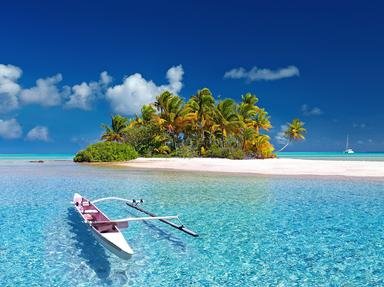Quiz Answer Key and Fun Facts
1. This island, which is 69 square miles in area, is also known as Bear Island. It was discovered by Norsemen in the 12th Century, and rediscovered in 1596. It was formally annexed by Norway in 1915.
2. Moving south, a Norwegian island again, taken over in 1929, this island boasts the most northern volcano in the world. It is uninhabited with only a weather station manned by a skeleton crew
3. Turning to the south-west, this island in the North Atlantic has the oldest legislative assembly in the world. It gained full independence from Denmark in 1944, and in 2003 had a population of around 280,000.
4. South-east now, this chain of 18 islands, 17 of which are inhabited, is home to 46,300 people, mostly of Danish origin. It has been self-governed since 1948, and has its own national football team.
5. Pushing south-west once more, this uninhabited small island has been claimed over the years by the UK, Ireland, Denmark and Iceland. It is only 19 metres high, 25 metres across, and 30 metres wide. It is home to many seagulls, and a navigational beacon was placed there by the UK in the fifties.
6. Travelling much further to the south-south-east, this Portuguese group of islands is halfway between Lisbon and New York. Its nine principal islands are home to around 275,000 people. Its largest city is Ponta Delgada.
7. To the west-south-west is a large British island which English colonists headed for Virginia in 1609 were shipwrecked. It has a population of around 65,000, and is made famous as a major offshore financial centre.
8. Heading east back across the ocean we come across another small island chain discovered by accident by the Portuguese in a storm. Almost 750,000 people live on the two main islands. Its capital is Funchal.
9. These famous islands, 14 in total, are owned by Spain and are a massive tourist spot with their long beaches and year-round fine weather.
10. Moving south-west again, this large group of islands just 500 kilometres from the African coast were a major hub for slave traders in the 18th century. They were granted Independence in 1975, though its 400,000 strong population still speak predominantly Portuguese.
11. Moving south-south-east and over the Equator, this small island is a relief US airfield for the Space Shuttle, and home to a small NATO force. It was used greatly during the Falklands war. It was originally named Conception island, and was officially claimed by Britain in 1815.
12. Traveling to the south-east, the next island we come to is a huge breeding ground for turtles, and has over 40 types of plant that can not be found anywhere else on Earth. Its population of 7,300 mostly leave the island to find work elsewhere, especially in the UK, where they save enough to live comfortably back on this island.
13. Moving across the ocean once more towards the west-south-west, this small island was originally covered in dense forest, but it is believed that volcanic gas from beneath the island killed all the plant life. Large goat herds on the island have prevented any real plant life from returning. It is just 50 square miles in size, and a hop, skip and a jump away from Rio de Janeiro at 750 miles.
14. This island, lying just to the west of the last, was made famous by a UFO sighting in 1958 from an American Navy ship. They observed and filmed a silver cylinder moving across the sky in excellent quality, leading to a flock of interest to this otherwise uninhabited rock
15. Traveling south-east, we find the most remote island in the world. It has just 300 inhabitants, and only seven surnames among them. The principal exports are crawfish, considered a delicacy across the world, and stamps, which people collect feverishly due to their rarity.
16. South-east again, we come across an uninhabited island with a huge rainfall of 2.5 metres per year. It is therefore very green and lush, but also rocky with sheer cliffs along its coast. It was formally mapped by a school party from England in the winter of 1983.
17. To the west-south-west now we find a large island group which was settled in 1833. It produces 80% of the UK's wool per year, and is currently having a large hydroponic greenhouse built upon it. It was invaded in 1982, but a British task force liberated it in the May of that year.
18. To the east-south-east is an island just 1000 kilometres from the Antarctic ice pack. It is home to seals, reindeer and a group of scientists. At the turn of the last century, it was a major whaling hub for ships in the South Atlantic.
19. Heading south-south-west there stands an island which used to be highly populated with seals, but they were hunted in the 19th century until literally only one remained. The island was named by a Scottish seal hunter, and is now divided between the UK and Argentina who both have scientific teams there.
20. And finally, to the north-north-east we find a tiny island discovered and named after a French Naval Officer in 1789. It was taken by the UK in late 19th century, but was officially handed over to Norway in 1928. They have built a weather station on it, and were one of the first teams to spot the ozone layer hole opening over the South Pole
Source: Author
SClelland
This quiz was reviewed by FunTrivia editor
minch before going online.
Any errors found in FunTrivia content are routinely corrected through our feedback system.
